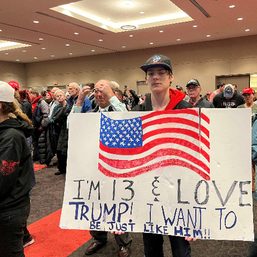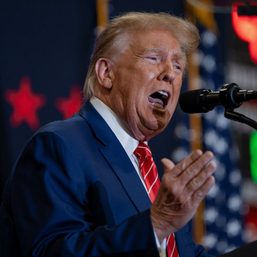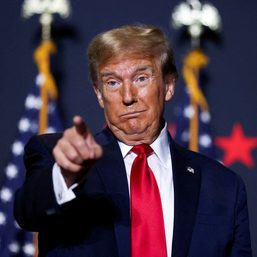SUMMARY
This is AI generated summarization, which may have errors. For context, always refer to the full article.

OHIO, USA – The US presidential race was a battle between the immoveable rock, President Barack Obama, and the unstoppable force, former Massachusets Governor Mitt Romney. The Republican candidate put up a huge fight but fell short in the end.
It was a blowout in the Electoral College: 303 for Obama versus Romney’s 206. Swing state Florida’s 29 remains hanging as of this writing. (Update: He won Florida, too.)
“It still was, percentage-wise, a close race. It just looks different when you look at the electoral map. These are series of tight races,” said senior political journalist Chris Booker of Columbus, Ohio’s WCMH-TV, the local affiliate of NBC.
In terms of actual votes, Obama got 60.5 million versus Romney’s 57.7 million. The 3-million margin may look wide but California alone gave Obama a lead of 2 million votes. In the 2008 presidential race, Obama led Republican candidate John McCain by over 8 million votes.
Series of tight races
It was a series of tight races in the only states that mattered on Election Day: swing states Ohio, Florida, Wisconsin, Iowa, Nevada, Virginia, Colorado, North Carolina, and New Hampshire.
Swing states are where votes could go either way on Election Day. The 41 other states and Washington, D.C. are battles that have long been won or lost. Candidates hardly go to the decided states to campaign. If at all, they go there to raise funds.
A big state such as California has 55 electoral votes, but it is a solid blue state. In terms of total, California gave Obama the biggest campaign donation: US$1billion.
It was clear Obama was way ahead in the estimates of the Electoral College. Seventeen decidedly blue states and Washington, D.C. gave him a starting point of 237 electoral votes, or 33 electoral votes short of the necessary 270 electoral votes to win the presidency.
Romney’s starting point was 206. Twenty-three states were decidely red, more than Obama’s 18. But most of these states have small population and thus smaller number of electoral votes.
Slim margins
The 9 swing states have a total of 95 electoral votes. There were various combinations for Romney to get 270, and when he performed better than Obama in the first presidential debate, Republican victory seemed likely.
Obama swept the swing states, but the margins were very slim. Obama led Wisconsin by about 200,000 votes. In the 6 other swing states, his lead was between 40,000 votes to 120,000. Romney only won North Carolina so far. Florida is still counting as of Thursday night, November 8.
In a country where voter turnout is within the 50% mark, it was a battle of ground game. It’s one thing to convince voters your candidate is better, it’s another to make them go out to vote, especially if the weather is not friendly.
African-American, Latinos, and young voters went out in droves – the same coalition that made Obama win in 2008. Women also favored Obama.
How Obama won Ohio
How Obama won swing state Ohio shows how his strategy worked in the rest of the swing states.
It is often said: As Ohio goes, so goes the presidency. Since 1964, whoever won Ohio won the presidential race. No Republican ever won the presidency without Ohio.
Ohio continued to hold that distinction. When Ohio was called for Obama late night on Election Day, the US presidential race was immediately called for Obama. Ohio favored Obama by a margin of about 100,000 votes.
“Ohio is the most swing of all swing states,” said former Ohio Gov Ted Strickland. “When you look at Ohio, it’s like America. Young and old, rich and poor, black, brown, yellow, and white, urban adn rural,” he told Rappler.
Ohio has diverse populations that are either supporters of the Republican Party or the Democratic Party. It has industrial cities, rural farmlands, and a capital that is a university town with high-tech industry.
The easternmost state in the midwest, it was one of the first swing states to close its polling and thus release its results. When Ohio was called, its 18 electoral votes put Obama’s total to 275 — or 5 electoral votes more than what he needed. It was a combination of his guaranteed 237, New Hampshire, and Obama’s “firewall” – the Midwest states Ohio, Wisconsin, and Iowa.
Political ads and auto bailout
NBC-4’s Chris Booker said it was a lot of things coming together that made Obama win.
Booker also debunked claims that superstorm Sandy aided Obama in stopping Romney’s momentum – at least not in Ohio. The superstorm forced both candidates to cancel campaign stops in Ohio and other swing states.
“Sandy hardly got Ohio,” he explained. Although Washington Post senior reporter David Ignatius said there was a value to the image of President Obama and Republican New Jersey Gov Chris Christie working together to help the storm victims that touched a cord among voters. (WATCH VLOG: Sandy throws campaign schedules into chaos)
“The country wanted problem solvers. They are sick of the political debate,” Ignatius said.
One of the larger reasons for the Ohio win was the controversial auto bailout that saved a lot of jobs in Ohio. Booker explained: “Early on in the President’s career, one of the first decisions he made was to give government money to the auto industry. A lot of jobs in Ohio are tied to that. It resonated with many voters – the blue collars in Ohio – which he needed to win.”
Romney’s published column opposing the auto bailout didn’t help him. In 2008, he wrote the column “Let Detroit go bankrupt,” which opposed aid to General Motors and Chrysler. In campaign speeches in Ohio, Obama harped on how the widely unpopular move to save the auto industry proved to be helpful.
Booker said Romney also had a poor response to the Obama camp’s campaign on the auto bailout.
Romney tried to counter the negative campaign with the “Jeep” ad campaign that aired toward the election. It claimed that the auto bailout was not as successful as portrayed. In a political ad that is believed to have backfired, the Romney camp said Obama’s auto bailout effectively allowed Italy to buy Chrysler, which will – the ad says – ship jobs to China.
Chrysler immediately issued a statement rebuking the ad.
The impact of political ads on the voters has yet to be measured. But Booker said: “We have a pretty highly informed electorate.” Many Ohio voters also expressed their disapproval of the intense negative campaigning from both sides. (WATCH: This Fil-Am is tired of Obama, Romney campaigns)
Romney’s best agument
What initially helped Romney was the slow economy under Obama, allowing his numbers to grow. In his campaign, Romney focused on creating jobs. He said he was offering “real change,” an obvious response to Obama’s 2008 slogan. Based on exit polls, the economy was the biggest concern among voters.
“The economy is still difficult around the nation. I think people don’t necessarily feel that we’re on the right track,” said Booker.
To counter it, a group supporting Obama ran what is believed to be a very effective ad. It was a simple testimonial of a former plant worker in Indiana, who was one of those Romney had supposedly fired when he shut down the plant. In the ad, the man claimed Romney made millions by shutting down the plant.
On the ground, the Obama camp got Bill Clinton – who remains to be well-loved by American voters – to campaign for him. In Clinton’s campaign event in Chilicothe, Rappler saw how voters lined to hear Clinton speak.
And then there are Romney’s missteps that the Democratic Party played up. Among them was the infamous “47 percent” comment that offended voters. Booker said it confirmed what voters already think Romney was.
Known to be moderate, Romney surprised political observers with his conservative positions during the Republican Primary – including his stand on abortion. While he succeeded to win the primary, his conservative stand turned off other voters.
Dwinding White voters
Rappler joined the campaign events of Obama and Romney in Ohio. Their supporters showed stark differences.
In Romney’s campaign event in a manufacturing plan in Pataskul, Ohio, the supporters who came were overwhelmingly white people. “We want to take America back,” they would say.
In contrast, attendees of Obama’s campaign were diverse: African-Americans, Latinos, Asian Americans. The same groups that showed a big turnout on Election Day.
“There is nobody else to vote for. He’s for the people. He’s gonna help everybody. He didn’t have the chance to do everything that needed to be done. Eight years of destruction takes a little longer to repair everything. When he doesn’t have a Congress that supports him, it’s a battle by himself,” African-American Mary Weeks told Rappler after she cast her vote in Columbus, Ohio.
Enthusiasm among Republican voters was also high, but the problem is they are a continously dwindling population.
“The white guys aren’t enough. White men voted substantially for Mitt Romney. He lost big time for a president who’s had a recession,” Ignatius said.
Ignatius also noted the growing political force of the Latinos. He said it’s possible that solid red state Texas – one of the Republicans’ biggest states – could turn blue in the next presidential elections because of its gowing population of Latino voters.
Some analysts say Romney’s loss was not a testament to the candidate but to the Republican Party and its conservative ideology that is turning off other sectors of the population.
“They have to find ways to adapt to the changing realities of their demographics,” said Booker. – Rappler.com
Add a comment
How does this make you feel?









There are no comments yet. Add your comment to start the conversation.